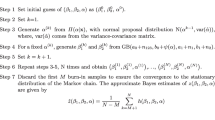Abstract
This paper studies time-to-ruin random vectors for multivariate risk processes. Two cases are considered: risk processes with independent increments and risk processes evolving in a common random environment (e.g., because they share the same economic conditions). As expected, increasing the dependence between the risk processes increases the dependence between their respective time-to-ruin random variables.
Similar content being viewed by others
References
N. Bäuerle, “Inequalities for stochastic models via supermodular orderings,” Communication in Statistics-Stochastic Models vol. 13 pp. 181–201, 1997.
F. Belzunce, E. Ortega, F. Pellerey, and J. Ruiz, “Variability of total claim amounts under dependence between claims severity and number of events,” Insurance: Mathematics and Economics vol. 38 pp. 460–468, 2006.
T. C. Christofides, and E. Vaggelatou, “A connection between supermodular ordering and positive/negative association,” Journal of Multivariate Analysis vol. 88 pp. 138–151, 2004.
J. Dhaene, and M. J. Goovaerts, “ On the dependency of risks in the individual life model,” Insurance: Mathematics and Economics vol. 19 pp. 243–253, 1997.
J. D. Esary, F. Proschan, and D. W. Walkup, “Association of random variables, with applications,” Annals of Mathematics Statistics vol. 38 pp. 1466–1474, 1967.
E. Frostig, “Ordering ruin probabilities for dependent claim streams,” Insurance: Mathematics and Economics vol. 32 pp. 93–114, 2003.
K. Jogdeo, “On a probability bound of Marshall and Olkin,” Annals of Statistics vol. 6 pp. 232–234, 1978.
H. Li, and S. H. Xu, “Structural analysis of a queueing system with multiclasses of correlated arrivals and blocking,” Operations Research vol. 26 pp. 305–321, 1999.
H. Li, and S. Xu, “On the dependence structure and bounds of correlated parallel queues and their applications to synchronized stochastic systems,” Journal of Applied Probability vol. 37 pp. 1020–1043, 2000.
H. Li, and S. H. Xu, “Stochastic bounds and dependence properties of survival times in a multi-component shock model” Journal of Multivariate Analysis vol. 7 pp. 63–89, 2001.
A. Müller, and M. Scarsini, “Some remarks on the supermodular order,” Journal of Multivariate Analysis vol 73 pp. 103–119, 2000.
A. Müller, and D. Stoyan, Comparison Methods for Stochastic Models and Risks. Wiley: Chichester, UK, 2002.
P. Picard, C. Lefèvre, and I. Coulibaly, “Multirisks model and finite-time ruin probabilities,” Methodology and Computing in Applied Probability vol. 5 pp. 337–353, 2003.
M. Shaked, and G. J. Shanthikumar, “Supermodular orders and positive dependence of random variables,” Journal of Multivariate Analysis vol. 61 pp. 86–101, 1997.
M. Shaked, and F. Spizzichino, “Positive dependance properties of conditionally independent random lifetimes,” Mathematics of Operations Research vol. 23 pp. 944–959, 1998.
S. Wang “Aggregation of correlated risk portfolios: models and algorithms,” Proceedings of the Casualty Actuarial Society pp. 848–939, 1998.
S. H. Xu, “Structural analysis of a queueing system with multiclasses of correlated arrivals and blocking,” Operations Research vol. 26 pp. 305–321, 1999.
S. H. Xu, and H. Li, “Majorization of weighted trees: A new tool to study correlated stochastic systems,” Mathematics of Operations Research vol. 25 pp. 298–321, 2000.
Y. Zhang, and W. Chengguo, “On the correlation order,” Statistics and Probability Letters vol. 76 pp. 1410–1416, 2006.
Author information
Authors and Affiliations
Corresponding author
Additional information
This article is dedicated to the memory of our beloved friend Benjamin Zeev Levikson who passed away on July 16, 2005.
Rights and permissions
About this article
Cite this article
Denuit, M., Frostig, E. & Levikson, B. Supermodular Comparison of Time-to-Ruin Random Vectors. Methodol Comput Appl Probab 9, 41–54 (2007). https://doi.org/10.1007/s11009-006-9004-4
Received:
Accepted:
Published:
Issue Date:
DOI: https://doi.org/10.1007/s11009-006-9004-4




